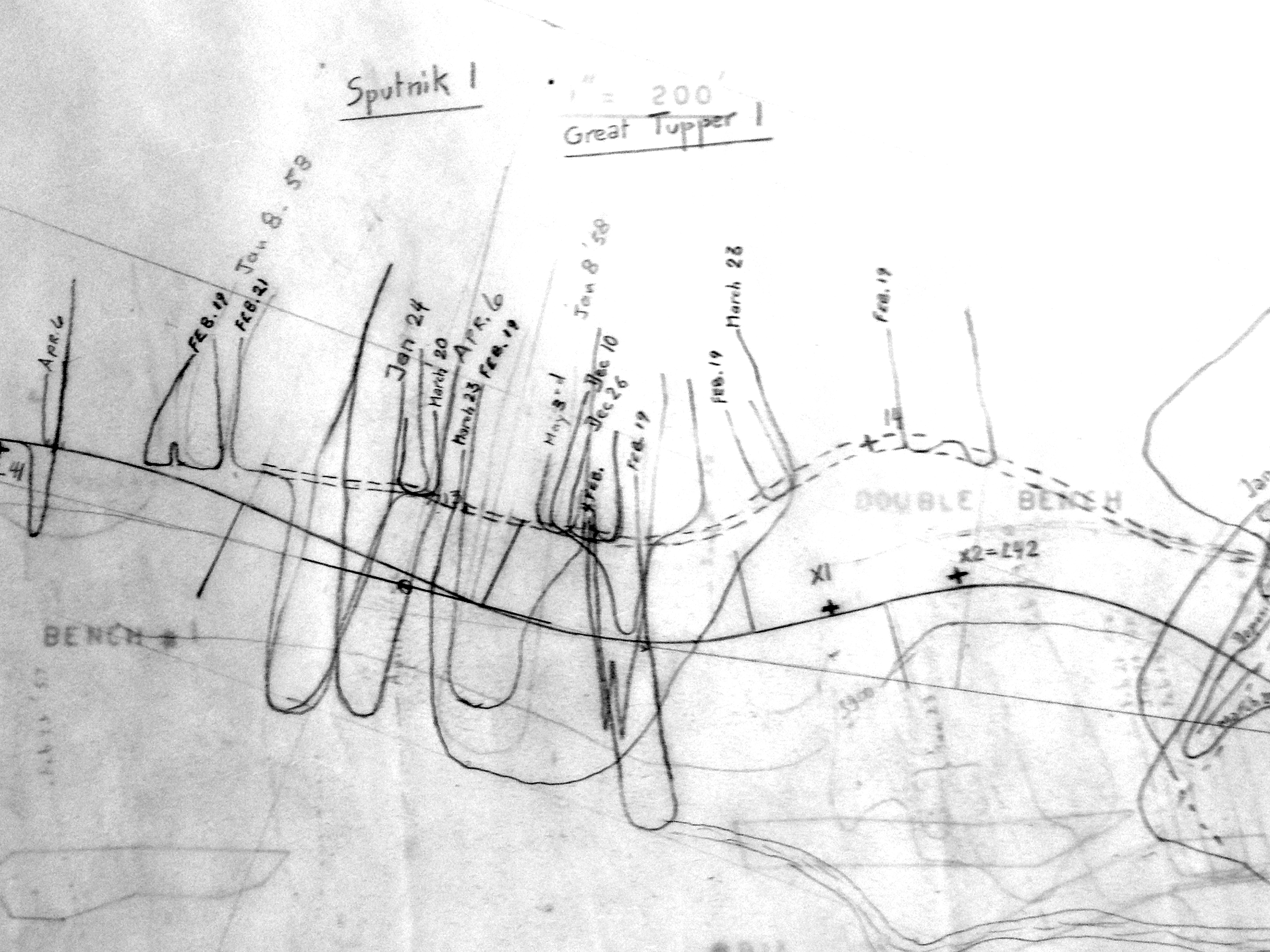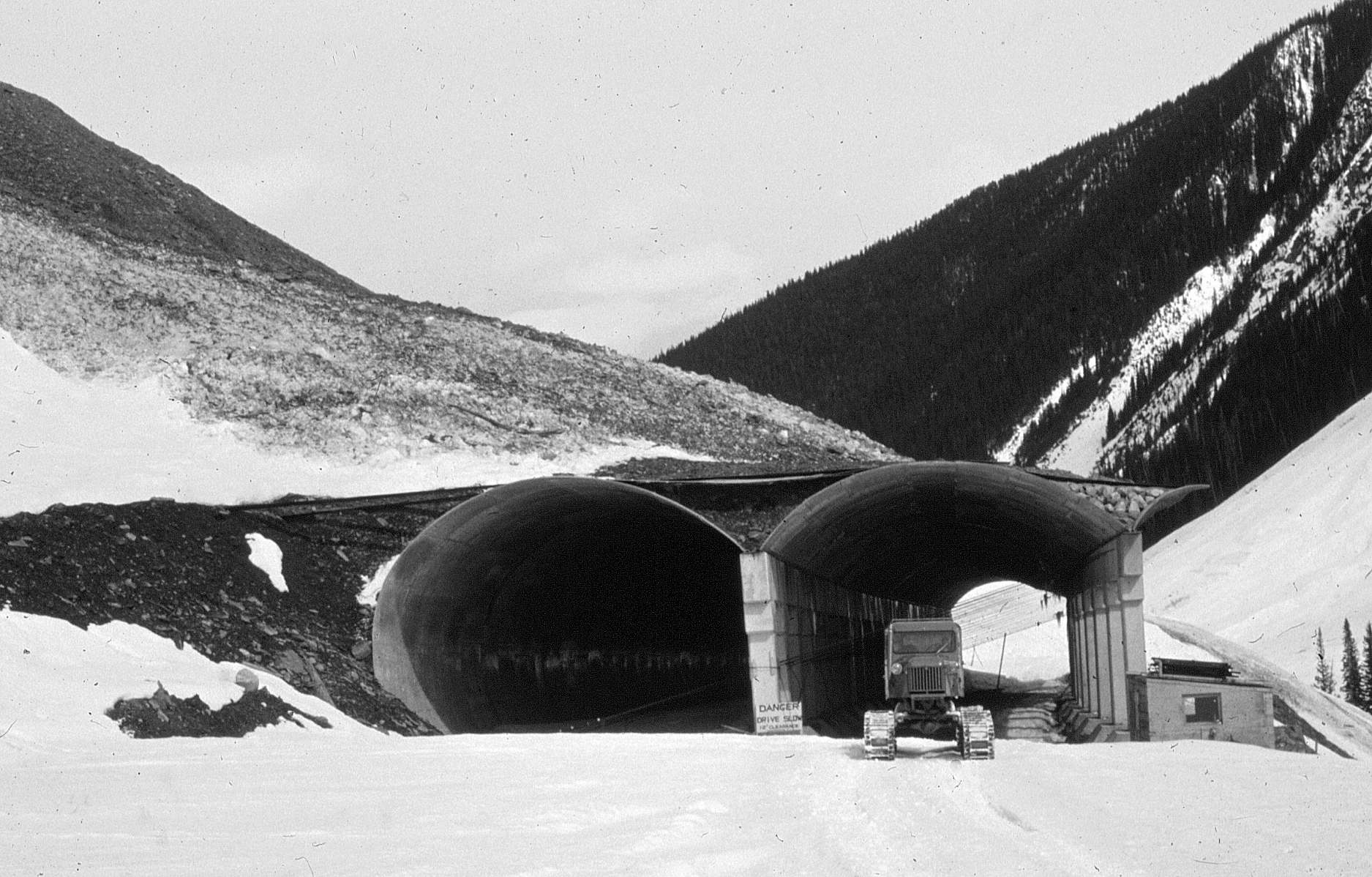From volume 105, winter 2013-14
By John G. Woods, Wildvoices Consulting, Revelstoke
On behalf of The Land of Thundering Snow Virtual Exhibit Project
ON OCTOBER 4, 1957, PEOPLE ACROSS CANADA AND AROUND THE WORLD LEARNED THE RUSSIAN WORD “SPUTNIK” WHEN THE SOVIET UNION LAUNCHED THE FIRST MAN-MADE SATELLITE INTO ORBIT. IN RECOGNITION OF THIS MOMENTOUS ACHIEVEMENT, THE NEWLY-ESTABLISHED AVALANCHE SAFETY TEAM WORKING IN ROGERS PASS THAT WINTER NAMED A SLIDEPATH ALONG THE PROPOSED ROUTE OF THE TRANS-CANADA HIGHWAY SPUTNIK 1.

FIG. 1: PLAN (PART) SHOWING AVALANCHE ACTIVITY DURING THE WINTER OF 1957-58 IN ROGERS PASS. NOTE THE ACTIVITY OF “SPUTNIK 1” SLIDEPATH ON JANUARY 8, 1958 // REVELSTOKE MUSEUM AND ARCHIVES
THE TRANS-CANADA Highway was under construction over Rogers Pass at the time and Sputnik 1 appeared on avalanche observation plans of the day (Fig. 1). Since a snowshed was planned for the highway across this slidepath, Sputnik 1 was the name used on the earliest construction documents for Canada’s first snowshed on a public highway.
Peter Schaerer was in charge of the avalanche survey crew that winter and describes the naming process in detail: “The crew of the Department of Public Works who observed avalanches and the weather in Glacier National Park in 1956-1960 was assigning names to the avalanche paths in 1957. The three major avalanche paths at Mount Tupper had been designated as Tupper No.1, No.2, and No.3 (actually, the idea popped up—but was abandoned—to rename them with the first names of the wives and girlfriends of the crew members). Because the name Sputnik was in everybody’s mind, we called the smaller avalanche path west of Tupper 1 “Sputnik No.1” and the path between Tupper 2 and Tupper 3 “Sputnik No.2.” The names were appropriate, because both paths were satellites of larger paths…” (personal communication, Schaerer-Woods, 2013).
The next year, after the United States launched their “Pioneer” rocket towards the Moon, the names of both the slidepath and the snowshed were changed to recognize this North American accomplishment. While the Rogers Pass avalanche atlas still includes the Pioneer slidepath (Schleiss, 1989), more experience during winter operating conditions resulted in connecting Pioneer and Tupper 1 sheds. The combined structure became the shed now called Tupper 1.
Pioneer Shed (a.k.a. Sputnik 1) was chosen as the site for the first snowshed because it was designed to be a relatively short shed—a good project to launch construction on what would become a suite of sheds protecting Rogers Pass’s eastern flank. This proved to be an excellent idea affecting the designs of all the subsequent sheds.
The ARMCO construction company won the contract to build this first shed and decided to use metal culverts supplied in multiple steel plates (Fig. 2). Unfortunately, the backfilling required to provide an even pressure distribution across the plates could not be completed by the first winter, and avalanches moved the structure out of position. The federal Department of Public Works lost confidence in metal designs and all subsequent snowsheds in the Pass were made of concrete (personal communication, Schaerer-Woods, 2013).

FIG. 2: PIONEER (A.K.A. SPUTNIK 1) SNOWSHED UNDER CONSTRUCTION IN 1961 // REVELSTOKE MUSEUM AND ARCHIVES PSS. 67
While the locations and designs of avalanche defences make use of the best available data on historic slide activity, projected traffic volumes, working challenges, and economic realities, nothing can compare with the learning that takes place once the structures are in place. Take for example Lanark Shed, on the Trans-Canada Highway just west of the western boundary of Glacier National Park. On January 1, 1963, slides overwhelmed both entrances to the shed trapping two cars and several people. While everyone was safely rescued after an eight-hour ordeal, this experience resulted in revisions to the shed design. By the following winter, tall concrete containment wings were added above both entrances (Woods, 2010).
In an incident on January 14, 1974, at Single Bench slidepath in Rogers Pass, an avalanche hit the avalanche control team (at the time called SRAWS—Snow Research and Avalanche Warning Section) in Rogers Pass just west of the existing sheds during a control shoot along the highway. Although no one was seriously hurt, the results were spectacular and ominous. A parked semi-transport truck was sent flying through the air, SRAWS and army vehicles were dislodged and damaged, and the 105-mm Howitzer used to initiate the slide was put out of commission (personal communication, Bay-Woods, 2013). Today, Single Bench Shed protects both highway travellers and avalanche control crews at this location.
Canada’s history of studying avalanche terrain and activity along transportation corridors dates from the winter of 1884-85. The Canadian Pacific Railway staffed “snow camps” in and adjacent to Rogers Pass throughout that winter to observe weather and avalanche activity. Their observations were vital to the location and design of the numerous snowsheds that would be needed to allow year-round operation of the railway across the Selkirk and Monashee mountains. In addition to numerous reports to the railway company, one of the survey engineers presented a landmark professional paper on the topic of avalanches and shed design at a meeting of the Canadian Society of Civil Engineers (Cunningham, 1887).
Similar studies of avalanche activity for the potential construction of a highway through Rogers Pass started in the early 1950s (Schaerer, 1995; Webb, 2011). In a tenacious and dedicated career spanning more than five decades as an employee of the National Research Council of Canada and as a private consultant, Peter Schaerer played a key role in locating and identifying design requirements for all nine Canadian highway snowsheds—from Sputnik to the Great Bear.
ACKNOWLEDGEMENTS
I would like to thank Jim Bay, Peter Schaerer and Walter Schleiss for sharing their first-hand experiences related to Canada’s highway snowsheds. Jeff Goodrich of Parks Canada kindly provided access to the unpublished plan showing avalanche activity at Sputnik 1 in 1958. Jacolyn Daniluck of Parks Canada and Cathy English of the Revelstoke Museum and Archives offered valued editorial suggestions on early versions of this article.
SOURCES
Cunningham, G. C. 1887. Snow slides in the Selkirk Mountains Transactions of the Canadian Society of Civil Engineers 1 Pt. 2: p. 18-31.
Schaerer, P. 1995. Avalanche studies Rogers Pass 1956 – 1961. Unpublished.*
Schleiss, V.G. 1989. Rogers Pass Snow Avalanche Atlas Glacier National Park, British Columbia, Canada. Revelstoke, BC, Canadian Parks Service, p. 313
Webb, J.R. 2011. Tales of a Highwayman. J. R. Webb, selfpublished, p. 253*
Woods, J. G. 2010. Snow War: An Illustrated History of Rogers Pass, Glacier National Park, BC.*
* available for viewing at the Revelstoke Museum and Archives





